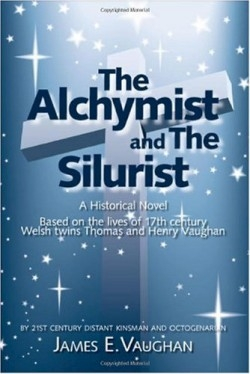The Alchymist and the Silurist
A Historical Novel
With a wordy reserved style slightly reminiscent of Dickens but without the old master’s knack for storytelling James E. Vaughan attempts to fictionalize the lives of his quirky and historical ancestors: Thomas the alchemist Vaughan and his twin brother Henry a metaphysical poet who referred to himself as the Silurist. “Silurist” is of course a reference to his Welsh heritage.
The author spins his wheels on the obvious omitting details that might bring this novel to life: “After spending a fortnight together in London Henry Vaughan sent his new bride to his home at Newton to live with her father and mother until the war ended….Although neither spoke of it at first both young men were fully aware that the second phase of the war would be no better than the first.”
Strong on research but weak on presentation this novel offers a constrained view of the seventeenth-century Welsh twins. It opens in 1645 when the brothers take up the Royalist cause against Cromwell and the Roundheads. The young men’s father prudently seeing that the war is lost to the “Parliamentarians and Puritans” urged the brothers to return to salvage what they could of their lands and possessions. Thus they left the battlefield eventually entered education at Oxford pursued their diverse passions married women for love and became a part of history.
Henry known today as one of the finest poets of the metaphysical school fashioned his writings after John Donne and George Herbert. Much has been written about him in studies of the metaphysical poets and in a respected biography. Thomas a member of the Society of Unknown Philosophers turned to medicine and mysticism specializing in the making of medicines according to the teachings of Paracelsus. In his alchemy pursuits he worked closely with his wife Rebecca something unheard of in that era. Among those pursuits they sought to find the legendary philosopher’s stone. Thomas died in a swirl of mercury vapors and Henry as with many writers and poets died in near obscurity only coming to prominence after his death.
The author of this novel is a member of the Arkansas Educational Telecommunications Commission and has published more than sixty instructional books including NASA’s Second Edition of Software for Aerospace Education in 1990. He writes clearly and concisely in a chronological reportage style employing few fictional techniques such as scene painting irony or metaphor. Humor seems nonexistent: “There was a lull in their conversation and Henry chose this juncture to retrieve yet another of his manuscripts. When he handed it over to Thomas he did so with obvious pride. “Here” he said “you asked what I did of a less serious nature.”
Those looking for a lighthearted historical novel should look elsewhere. Anyone interested in learning about these historical figures may do better to seek out their biographies.
Disclosure: This article is not an endorsement, but a review. The publisher of this book provided free copies of the book and paid a small fee to have their book reviewed by a professional reviewer. Foreword Reviews and Clarion Reviews make no guarantee that the publisher will receive a positive review. Foreword Magazine, Inc. is disclosing this in accordance with the Federal Trade Commission’s 16 CFR, Part 255.

